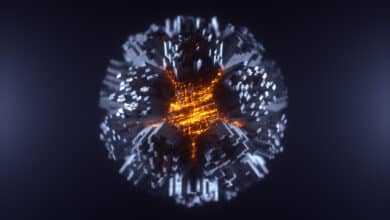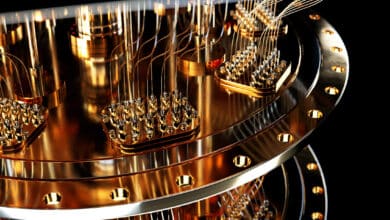Quantum Computing Modalities: Hybrid QC Architectures

Table of Contents
(For other quantum computing modalities and architectures, see Taxonomy of Quantum Computing: Modalities & Architectures)
What It Is
Hybrid quantum computing architectures refer to combining different types of quantum systems or integrating quantum subsystems with one another (and often with classical systems) to create a more powerful or versatile computer. This can mean hybridizing physical qubit modalities (e.g., using both superconducting qubits and photonic qubits together), or mixing analog and digital quantum methods, or even quantum-classical hybrids where a quantum processor works in tandem with a classical co-processor. The goal of hybrid architectures is to capitalize on the strengths of each component while mitigating individual weaknesses.
Several forms of hybridization include:
- Heterogeneous Qubit Systems: Having more than one kind of qubit in the same machine. For example, a system where superconducting qubits do fast logic but communicate via optical photons to distant nodes (thus involving both microwave (supercond) and optical (photonic) elements). Or a hybrid of trapped ions and superconducting qubits, where ions could serve as long-lived memory qubits and superconductors as processing qubits.
- Quantum Network of Modules: A distributed quantum computer where each module might be a small quantum processor (like 50 superconducting qubits on a chip, or 50 trapped ions in a trap), and modules are connected by quantum links (optical fibers or free-space photons). This is hybrid in the sense of spatially separated quantum components connected by communication channels. Oxford’s recent demonstration linking two ion trap processors by photonic teleportation is a prime example. In the future, networks of dozens of modules could act as one large computer.
- Hybrid of Computing Modalities: E.g., combining analog quantum simulation/annealing with digital gates. A specific case is the Quantum Approximate Optimization Algorithm (QAOA) which uses a parameterized sequence of analog Hamiltonian evolutions and digital operations, blending gate model with annealing concepts. Another example is using an analog quantum simulator as a subroutine inside a digital algorithm or vice versa.
- Quantum-Classical Hybrid Algorithms: While not hardware hybridization, in practice most near-term algorithms (like variational quantum eigensolver, VQE) are hybrid: a classical computer optimizes parameters for a quantum circuit. The architecture might physically integrate a quantum processor with a classical HPC system for tight feedback loops. Many current quantum cloud offerings integrate classical pre/post-processing with quantum jobs intimately.
- Cross-platform error correction or memory: Possibly using one technology for processing and another for memory. For example, NV centers in diamond have an electron spin (good for fast ops) and nearby nuclear spins (good for long storage); that’s a hybrid at the qubit level. Or one could transfer quantum info from a superconducting qubit to a long-lived atomic memory (like a neutral atom or ion) for storage, then back when needed.
- Different qubit connectivity mediums: A hybrid could use multiple interconnect types – e.g., electrical coupling for nearest neighbors and optical coupling for long-range, in one machine.
Comparison
A hybrid approach often arises from trying to solve the scaling issues of a single-tech architecture. For instance, superconducting qubits are fast but connecting thousands on one chip is wiring-heavy and limited by 2D chip area; linking multiple chips optically (a photonic interconnect) gets around that, at the cost of introducing a different tech (microwave-to-optical transducers, beam splitters, etc.). Trapped ions have all-to-all connectivity in one trap but slow gates; a hybrid could be multiple small traps each fast within themselves, linked by photonic network to preserve all-to-all among modules. Essentially, hybrid architectures aim to be greater than the sum of their parts.
The downside is complexity: mixing technologies means you inherit the challenges of all, and interfacing them adds additional challenges.
Advantages
- Scalability via Modularity: Instead of forcing one monolithic device to have 1 million qubits (which might be physically unmanageable), hybrid networks can connect many smaller devices. Each module can be optimized and fabricated/tested independently, then networked. This is akin to classical computing scaling via multi-core processors and clusters. The Oxford experiment demonstrated the feasibility of distributed quantum gates across modules, showing you can perform entangling operations even when qubits are in different cryostats or traps by teleporting information.
- Combining Speed and Coherence: Different qubit types excel in different aspects. Superconducting qubits have fast gate speeds (nanoseconds) but decohere in microseconds. Trapped ions have slow gates (tens of microseconds or more) but can maintain coherence for seconds or minutes. A hybrid could use superconducting qubits to do many operations quickly, and intermittently swap the quantum state into ion qubits (or nuclear spins) to hold while waiting or during algorithmic steps that allow a pause. That could effectively give a quantum memory. There are proposals to have an ion or cold atom memory for superconducting processors since microwave photons can swap into ions via cavities.
- Best of Both Worlds in Communication: Photons are great for communication (flying qubits), but not for storing or processing (they fly away, measuring them consumes them). Matter qubits (atoms, ions, solid-state) are great for processing but typically bad for long-distance link (can’t move easily, or require transport that is slow). A hybrid of matter qubits for compute and photonic qubits for links leverages each where appropriate. Many projects, like the EU’s quantum internet plans or US quantum network projects, effectively consider small quantum computers connected by photons.
- Parallel Processing and Specialized Modules: Hybrid architecture can also mean specialized quantum hardware living together. Perhaps one module is particularly good for simulation of chemistry (an analog quantum simulator), another is a digital QPU good for logic operations. They could work together on a task (the analog part simulates a molecule’s Hamiltonian dynamics, the digital part does phase estimation with that as subroutine). This specialization could reduce the overhead compared to doing everything in one modality.
- Fault Tolerance Distribution: The overhead of error correction might be reduced if one uses hybrid ideas. For example, topological qubits (Majoranas) might act as ultra-stable memory qubits, while a fast but noisy processor does operations and then information is parked in the topological qubits. That could reduce needed error correction on the processor since memory is safe. Hybrid classical-quantum error correction is also considered (classical processors correcting quantum errors in real-time, which of course we will do).
- Resource Flexibility: In a hybrid network, if one module fails or has lower fidelity, you could potentially route more operations to another module. It’s more flexible (like cloud computing can allocate more tasks to one server if another is slow). Similarly, one could upgrade one part of the system (say swap out a module with a better one) without rebuilding the whole thing. Dougal Main from Oxford noted modules can be upgraded or replaced flexibly in their network.
- Complementary Cybersecurity Benefits: Hybrid architectures could potentially enable secure quantum cloud computing: you keep some qubits local (for sensitive data) and others remote. Or generate distributed keys via entanglement. A hybrid net of quantum machines is essentially also a quantum communication network.
Disadvantages
- Interface Complexity: Each interface (boundary between different tech) is a point of inefficiency and error. Example: converting a microwave photon from a supercond qubit to an optical photon to send through fiber – current transduction efficiencies are <1% (lossy). That introduces error or requires repetition (entanglement swapping many tries). Similarly, coupling an ion to a superconducting resonator for memory transfer is experimentally challenging: you have vastly different frequency domains and coupling strengths. So building reliable interfaces often lags behind individual qubit advances. If those aren’t high-fidelity, the hybrid’s advantage is lost. The experiment linking traps achieved an entangled state with fidelity ~0.9 over fiber, which is good but not at error-corrected levels. Improvement is needed.
- Synchronization and Latency: When you connect modules, you introduce communication latency. Even at speed of light, if modules are meters apart, it’s a few nanoseconds delay – trivial compared to gate times. But more significant is waiting for a successful entanglement link (which might be probabilistic). The Oxford demo likely had to attempt many photon transmissions to get one entanglement (they used a single-photon detection scheme). There’s also classical communication needed in some schemes (like after entangling two nodes, you send a classical signal to confirm and perform a gate accordingly). This slows things down. So a distributed quantum algorithm likely has more overhead in time for communication steps, similar to distributed classical computing overhead.
- Resource Overhead for Interfaces: To mitigate probabilistic linking, one uses entanglement swapping, quantum repeaters (with possibly many auxiliary qubits for error correction of links). The hybrid network might need significantly more qubits just for the interconnect (like memory qubits to store entangled states, error-correcting the photonic channels, etc.). This adds complexity and cost – for instance, a quantum repeater might need local quantum processors itself to correct link errors.
- Calibration and Control: Each module might use different control hardware (lasers for ions, microwaves for superconductors, etc.). Combining them means you need all those control systems in one setup, which is expensive and complex. Cross-talk between systems (laser light might interfere with superconducting circuits if stray photons enter the fridge, etc.) has to be carefully managed with shielding and design.
- Software Complexity: Programming a hybrid system is harder – one might need to decide which qubits (or modules) do which parts of an algorithm. It introduces a mapping problem akin to parallel computing or heterogeneous computing (like using CPU+GPU: one must partition tasks). Quantum compilers will need to allocate and schedule operations across modules and communication channels. That’s a richer problem but more complex to solve optimally.
- Not Many Experimental Demonstrations Yet: Apart from photonic links between identical modules (ion-ion, supercond-supercond via photons), and hybrid qubit experiments like NV center (electron + nuclear spin) or donor in silicon (electron + nuclear), we haven’t seen, say, a superconducting qubit entangled with an ion or an NV center strongly (there are attempts: e.g., hooking a transmon to a spin ensemble in diamond was tried to act as memory, but with limited success). So some pairings might face fundamental difficulties.
Cybersecurity Implications
On the offensive side, hybrid architectures mainly impact when quantum computers will be able to break encryption, rather than introducing new methods to do so. If hybrid approaches succeed in scaling qubits faster, the moment of cryptographic vulnerability comes sooner. For example, a network of 10 modules with 100 qubits each, effectively 1000 qubits, could be achieved earlier than a single-chip 1000-qubit machine if each module was easier to build in parallel. As the NSA or other agencies consider threat timelines, a breakthrough in hybrid networking like the Oxford result suggests that linking many small quantum computers to act in concert is feasible, meaning even if individual machines remain small, attackers could pool them to tackle larger problems. So, one must consider distributed quantum computing in threat models (much like botnets in classical computing: many small devices collectively achieving a big computation).
For defense, hybrid quantum networks are exactly what’s needed for quantum key distribution (QKD) on large scales and quantum-safe networks. The technology to connect quantum nodes via photons underpins quantum communication. So, advances in hybrid architectures also advance quantum cryptographic infrastructure. The Oxford experiment even aligns with the vision of a quantum internet where quantum processors are nodes that can share entanglement on demand. Such networks can do secure multi-party quantum computation or distribute entangled pairs for QKD between any two end nodes.
Another cybersecurity angle: cloud quantum computing security. If you have a modular quantum computer where different modules might be at different physical locations (or owned by different parties), one might worry about security of the data moving between modules. Ensuring entanglement distribution is done securely (no intercepting or tampering with the photonic links) becomes an issue. Though quantum links have the advantage that tampering usually detectable (like in QKD, eavesdropping changes states). Also, if one envisions clients having their own small quantum devices that link with a cloud quantum server (a hybrid client-cloud architecture), protocols need to ensure the client’s quantum data is not leaked to the server or vice versa beyond what’s intended (this goes into blind quantum computation or delegated computing protocols).
Who’s Pursuing
- Pretty much all major quantum computing efforts have some eye on hybrid.
- Big companies: IBM is focusing on multi-chip quantum processors (scaling via chip modules with maybe interposers or solder bumps). Google is investigating photonic links for their superconducting qubits too (they published on a flip-chip device for frequency conversion). Microsoft might consider hybrid with topological qubits plus regular ones for universality.
- Startups:
- PsiQuantum: purely photonic, but they mention perhaps connecting photonic chips via fibers (though their aim is one big photonic chip).
- Honeywell (Quantinuum): their next-gen ion traps likely incorporate photonic links between multiple traps (their current device already has 2 traps connected by chaining ions, but photonic is next).
- IonQ: as above, modular trap network is on roadmap.
- Rigetti: has a multi-chip architecture under development (for example, 80-qubit system is 2 chips of 40 with coupling bonds).
- Intel: investing in silicon photonics for connecting their spin qubit arrays.
- QphoX (Netherlands): a startup specifically building microwave-optical transducers to connect superconducting qubits to optical fiber networks.
- Academic consortia: Quantum Internet Alliance, USTC in China (they did distributed photonic computing demonstrations, like entangling two superconducting qubits via photons transmitted over 50 km fiber in 2021).
- Government labs: Aforementioned NIST, also Oak Ridge and Sandia have projects on heterogeneous integration (Sandia has ion traps and superconducting foundries, exploring integration; ORNL looks at photonic interposers etc.).
In summary, hybrid architectures represent the “system engineering” phase of quantum computing – moving from isolated components to a network of components working together. It’s analogous to multi-core distributed computing in classical, which was crucial for scaling beyond single-processor limits. As such, it’s a near-inevitability for large-scale quantum computing and a very active area of R&D.



